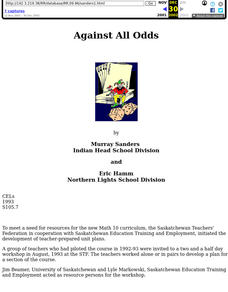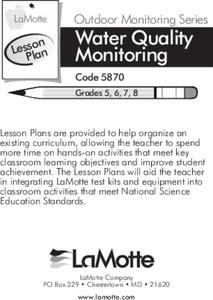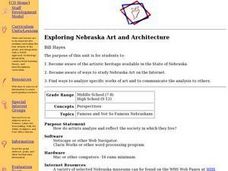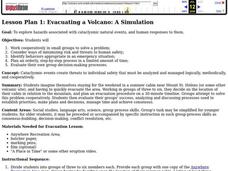Curated OER
Toothpicks and Timber
Students problem-solve how to log five acres. Working in pairs, they construct models of logging sites before and after the trees are harvested. they paint their models and include other environmental details.
Curated OER
Tall Tales: Reconstructing A Personal Tell
Sixth graders discover the ways archaeologists examine artifacts and where they are found. After being introduced to new vocabulary, they use artifacts from their own lives and discover what could be told about their life from them. ...
Curated OER
Birds of Wisconsin
First graders explore the job done by ornithologists. They role play identifying the characteristics that make a bird a bird. They discuss what makes each bird species unique. Students are introduced to Wisconsin's most common and rare...
Curated OER
Cause-Effect Fishbone Diagrams
In this cause and effect worksheet, students read about the cause/effect relationship and how to analyze using a fishbone diagram. Students are given a blank template of a diagram.
Curated OER
Against all Odds
Tenth graders appreciate the role of probability in understanding everyday situations. They Communicate a summary of financial projections in appropriate reports, tables, and graphs after creating a new game of chance.
Curated OER
Molecular Evolution in Plants
Pupils examine chlorophylls. They explore the absorbing pigments in a variety of plants. Through activities, students determine spectrophotometrically. They compare plant proteins from the family Brassicace to assess the level of...
Curated OER
The Cycle of Restoration
Students describe what is meant by restoration cycle. In groups, they create a poster to show the cycle of restoration work. After presenting their poster, they discuss the actions that can be done for each season. To end the lesson,...
Curated OER
Shark Attack
Young scholars examine the white shark. They think critically about a set of shark facts and predict whether the statements are true or false. Students describe a year in the life of a white shark living in the Red Triangle. They...
Curated OER
What's It All About?- Kansas Prairies
Students examine the interdependence of animal life and the environment. In this Kansas prairies lesson, students read background information on prairies and complete a worksheet to identify the main idea.
Curated OER
Water Quality Monitoring of Natural Water
Students create their own monitoring program for natural water. They collect samples from an appropriate sampling site. They perform chemical and biological analyses of their samples. They present their information to the class.
Curated OER
Water Quality Monitoring of Natural Water
High schoolers set up their own monitoring system. They collect samples from an appropriate sampling site. They analyze data and determine the water quality. They present their information to the class and draw a conclusion.
Curated OER
Optional Laboratory: Calculating Board Footage in a Tree
Middle schoolers work together to complete an experiment calculating the amount of board footage in a tree. They record their data and answer questions at the end of the lesson. They create their own hypothesis as well.
Curated OER
Is Your Water Clean?
Students conduct tests of water samples from different sources, such as a local river, tap water, and an irrigation ditch. After determining which pollutants are present in each sample, students hypothesize the possible sources of the...
Curated OER
Anatomy of the Brain
Students explore the brain. In this science lesson, students view a diagram of the brain and discuss the various regions of the brain. Students discuss the importance of protecting the brain and design a protective covering.
Curated OER
Which Dog for Me? Trivia Quiz
In this online quiz activity, students answer a set of trivia questions about dog breeds. Page has a link to submit answers for review.
Curated OER
History of Water Use in Hawaii
Students research water use in Hawaii and use primary and secondary sources to determine the impact of restoration of the L?l?kea stream on stream flow, water quality, habitat and biota.
Curated OER
Community Celebration
Sixth graders invite members of their community to a celebration in which they present information about what they have gathered during the Aqua Pure project. Using art, they unveil their projects to the community and extend their thanks...
Curated OER
Raising an Animal
Learners observe reproduction and behavior in several types of animals and nurture a sense of responsibility and cooperation. They then examine external features of several different types of animal groups.
Curated OER
Phrasal Verbs
In this verb usage learning exercise, students choose a phrasal verb from the list and then put the verb in the correct form. Students complete twenty-five sentences.
Curated OER
Salmon and Steelhead Life Stories Web Search
Students conduct an Internet investigation to discover the natural history of local salmon and/or steelhead. They then write a story that describes the life of a salmon or steelhead from the local creek, including a description of each...
Curated OER
Exploring Nebraska Art and Architecture
Students explore the art and architecture of Nebraska. Using the internet, they view artwork by various artists and analyze it by using a form given to them by their teacher. They share their analysis with their classmates and discuss...
Curated OER
Evacuating a Volcano: A Simulation
Students imagine themselves staying for the weekend in a summer cabin near Mount St. Helens (or other volcanic site,) and having to quickly evacuate the area.
Curated OER
Evacuating a Volcano: A Simulation
Students explore hazards associated with cataclysmic natural events, and human responses to them by creating emergency plans.
Curated OER
Some Early Spring Flowers
In this counting flowers learning exercise, students cut out five different bouquets of flowers, count how many flowers are in each bouquet and then place each bouquet in the appropriate numbered vase.

























